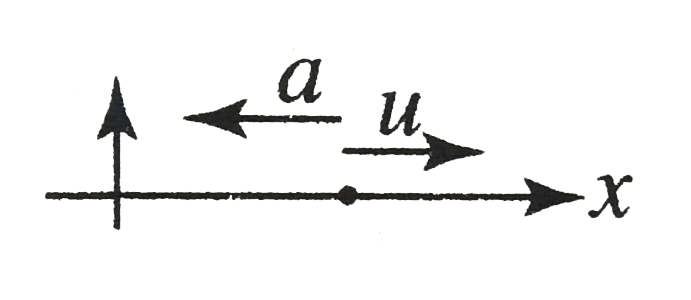A particle is projected in such a way that it follows a curved path with constant acceleration . For finite interval of motion. Which of the following option may be correct
initial velocity acceleration of particle velocity at
The correct Answer is:A, D
To solve the problem, we need to analyze the motion of a particle projected in a curved path with constant acceleration. We will evaluate the four options given in the question, focusing on the relationships between initial velocity (u), acceleration (a), and velocity at time t (v).
1. Understanding the Motion:
- The particle is projected with an initial velocity →u.
- It experiences a constant acceleration →a.
- The velocity at time t is given by →v=→u+→at.
2. Analyzing the First Option:
- The first option states that →a×→u≠0.
- The cross product →a×→u is zero only if →a and →u are parallel (i.e., the angle between them is 0 degrees or 180 degrees).
- Since the particle is moving in a curved path, →a cannot be parallel to →u for the entire motion. Therefore, this option is correct.
3. Analyzing the Second Option:
- The second option states that →a×→v=0.
- Since →v=→u+→at, we can express the cross product as →a×(→u+→at).
- The cross product of →a with itself is zero, but →a×→u is not zero (as established in the first option). Thus, this option is incorrect.
4. Analyzing the Third Option:
- The third option states that →u×→v=0.
- Since →v=→u+→at, we have →u×→v=→u×(→u+→at).
- The cross product →u×→u=0, so this option is also incorrect.
5. Analyzing the Fourth Option:
- The fourth option states that →u⋅→v=0.
- The dot product →u⋅→v=→u⋅(→u+→at)=→u⋅→u+→u⋅→at.
- This dot product is zero only if the particle is in circular motion, where →u and →a are perpendicular. Thus, this option is correct for circular motion.
Final Evaluation of Options:
- Option 1: Correct (→a×→u≠0)
- Option 2: Incorrect (→a×→v≠0)
- Option 3: Incorrect (→u×→v≠0)
- Option 4: Correct (→u⋅→v=0 for circular motion)
Summary of Correct Options:
The correct options are:
- Option 1: →a×→u≠0
- Option 4: →u⋅→v=0 (for circular motion)
- The particle is projected with an initial velocity →u.
- It experiences a constant acceleration →a.
- The velocity at time t is given by →v=→u+→at.
- The first option states that →a×→u≠0.
- The cross product →a×→u is zero only if →a and →u are parallel (i.e., the angle between them is 0 degrees or 180 degrees).
- Since the particle is moving in a curved path, →a cannot be parallel to →u for the entire motion. Therefore, this option is correct.
- The second option states that →a×→v=0.
- Since →v=→u+→at, we can express the cross product as →a×(→u+→at).
- The cross product of →a with itself is zero, but →a×→u is not zero (as established in the first option). Thus, this option is incorrect.
- The third option states that →u×→v=0.
- Since →v=→u+→at, we have →u×→v=→u×(→u+→at).
- The cross product →u×→u=0, so this option is also incorrect.
- The fourth option states that →u⋅→v=0.
- The dot product →u⋅→v=→u⋅(→u+→at)=→u⋅→u+→u⋅→at.
- This dot product is zero only if the particle is in circular motion, where →u and →a are perpendicular. Thus, this option is correct for circular motion.
- Option 1: Correct (→a×→u≠0)
- Option 2: Incorrect (→a×→v≠0)
- Option 3: Incorrect (→u×→v≠0)
- Option 4: Correct (→u⋅→v=0 for circular motion)
The correct options are:
- Option 1: →a×→u≠0
- Option 4: →u⋅→v=0 (for circular motion)
Topper's Solved these Questions
- DAILY PRACTICE PROBLEMSBOOK - RESONANCE ENGLISHCHAPTER - DAILY PRACTICE PROBLEMSEXERCISE - dpp 19
4 Videos
- DAILY PRACTICE PROBLEMSBOOK - RESONANCE ENGLISHCHAPTER - DAILY PRACTICE PROBLEMSEXERCISE - dpp 20
8 Videos
- DAILY PRACTICE PROBLEMSBOOK - RESONANCE ENGLISHCHAPTER - DAILY PRACTICE PROBLEMSEXERCISE - dpp 17
7 Videos
- CURRENT ELECTRICITYBOOK - RESONANCE ENGLISHCHAPTER - CURRENT ELECTRICITYEXERCISE - Exercise
53 Videos
- ELASTICITY AND VISCOCITYBOOK - RESONANCE ENGLISHCHAPTER - ELASTICITY AND VISCOCITYEXERCISE - Advanced Level Problems
9 Videos
Similar Questions
Knowledge Check
A particle moves in a plane with a constant acceleration in a direction different from the initial velocity. The path of the particle is
Astraight lineBarc of circleCparabolaDellipse
The initial velocity of a particle is u (at t = 0) and the acceleration f is given by f=αt. Which of the following relation is valid?
View SolutionA particle is projected at t=0 with velocity u at angle θ with the horizontal. Then the ratio of the tangential acceleration and the radius of curvature at the point of projection is :
View SolutionA particle moves such that its momentum vector →p(t)=cosωtˆi+sinωtˆj where ω is a constant and t is time. Then which of the following statements is true for the velocity →v(t) and acceleration →a(t) of the particle :
View SolutionA particle moves rectilinearly with initial velocity u and constant acceleration a. Find the average velocity of the particle in a time interval from t=0 to t=t second of its motion.
View SolutionAverage velocity of a particle moving in a straight line, with constant acceleration a and initial velocity u in first t seconds is.
View SolutionAverage velocity of a particle moving in a straight line, with constant acceleration a and initial velocity u in first t seconds is.
View Solution

For a particle moving along straight line with constant acceleration (a), we define velocity of the particle with time as
v=u+at, (u=initial velocity)
Draw the velocity-time graph of the particle in following situations.
(i) Velocity is decresing with time (i.e., acceleration in negative)
(ii) Initial velocity is negative but acceleration is positive
View Solution
